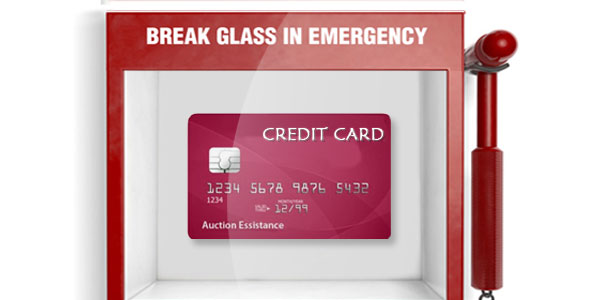"Save up with an emergency fund" - You must have come across this advice several times.
But, do you know that you can even keep a credit card safe for the emergencies?Not that it's essential, but your emergency credit card may come in handy when you land up with an unexpected financial crisis.
An emergency card is just like any other credit card until you decide to make it work differently. Instead of using it for your regular requirements, you keep it safe to be used during emergencies only.
Thus, it works more or less like your customized insurance policy, which you can use whenever you need it the most.
How to make sure you have the best emergency card
Well, no credit card can be termed outright as 'best'. However, before you decide to keep one safe for your crisis situations, you need to keep the following factors in mind:
- Considerable credit limit: Unexpected circumstances don't come with a warning, and you never know how much you'll need to spend. Therefore, maintaining a substantial credit line is important to save the card for emergency usage. Usually, maintaining a credit limit of $5,000 makes sense, just in case you would need it (for an emergency. However, your credit history, present financial condition, and the credit card issuer's discretion are the primary factors, which will affect your available credit limit.
- Universally accepted: Just as you don't know how much you're going to need during or after a crisis, you also wouldn't know where it might be used. General purpose cards with Visa or MasterCard payment systems are usually accepted at most of the places, and thus it's better if your emergency credit card has that power of universal acceptance.
- Revolving credit account: Since you wouldn't know how large the balance is going to be, you won't be able to plan the repayment. Make sure that it's a credit card which comes with a revolving credit account so that you can pay the balance over time according to your convenience. Charge cards might allow you large balances but has to be paid off in about 30 days, which might be difficult for you, especially after emergencies./li>
- Should be used during emergencies: You need to keep in mind the purpose of the card at all times and make sure that you don't use it until necessary. The card shouldn't be used for your regular purchases. Otherwise, it would be a futile attempt of saving it as an emergency card.
- Card should be in good standing: Even then, hanging onto the card without using it at all, is also not recommended. Card issuers might cancel inactive cards. Therefore, you can make on-and-off purchases, and pay off the balance in full every month to keep the account status active and in good standing. However, such transactions should be kept small at all times.
Recognizing a seriously urgent situation as an “emergency”
Different individuals have a different perception of emergency. When it comes to using emergency credit cards, the most important thing to determine is whether or not an emergency is a “serious emergency”.
Most financial counselors accept that they even come across women who consider a shoe sale as an emergency. Some households insist on booking a vacation during a time when a layoff is looming.
The term “emergency” is rather very subjective, which is an emergency to A might not be an emergency to B.So, the million dollar question is ‘when to use’ and ‘when not to use’ an emergency credit card?
In this context, as already mentioned, you should remember that saving the card for only emergencies can be a bad idea since credit card companies may close the account due to less or no usage. You may find that your card is not working when you need it on an urgent basis.
Experts suggest that to avoid this kind of a hassle, people may use their emergency card for a purchase that they can pay either with a small payment or an automatic payment every month.
The central motif is to keep the card active and in good standing.So, as per the experts, when is it a good idea to use an emergency credit card?
- To avoid danger:If you're traveling in a risky area and become abandoned, then you can use your credit card to rent a car for reaching a safe place or to book a hotel room.
- To fix a major home damage project:
If your home needs a repair, and insurance doesn't cover it, then using an emergency credit card may be a good idea. Using an emergency card makes sense for a major car repair as well. But, ensure that the card is not used for a car maintenance. Some expenses that most of the people mistakenly consider as emergencies are as follows:
- Broken appliances and electronics:Repairing a broken DVD player, dishwasher, and high-tech gadget isn’t considered as an emergency. Try to save money to repair or replace them.
- Celebrating birthdays, Christmas, giving gifts:Buying birthday gifts or hosting a party using a credit card will be considered as a blunder. Birthdays, Christmas celebration, etc. happen every year. Try to give homemade gifts or set aside money for arranging parties.
Read more: Best and worst charge: 7 Things a credit cardholder must know
Non-financial reasons to use an emergency credit card
Apart from the multiple financial reasons of carrying an emergency card, you can keep such a card for some practical purposes as a backup.
Have a look at different non-financial reasons to use an emergency card.
- Loss of cards: It often happens that credit cards get lost or wear out due to long term usage. If your card gets lost, it is most likely that you will need an interim card for daily needs, but if you have an emergency card, you can at least use it until you restore your previous card.
- Cuts in credit limits: As a reaction to the recession and the financial troubles, banks often make the decision to trim down credit limits. Often such decisions are carried out without informing the card holders. Having less credit may hurt your scores and bar your borrowing options. Having an emergency backup card can soften the blow.
- Anti-fraud programs: Card issuers have the right and the authority to cut off a card if they sense any unusual behavior. Such false steps from the anti-fraud programs can leave you stranded if you don’t have a backup card.
How to use an emergency credit card without welcoming debt clutches
Using an emergency credit card properly is highly recommended; otherwise, it may arise financial problems. The card should not be your only resort for any problems.
- Make payments within time: If you decide to use your card, then make sure you charge only an amount that you can pay off in a given period. Never make the mistake of charging an amount that is more than what you can pay off in 3 months. If you think you still have to incur balance, then get a second job and try to boost your passive source of income so that you can repay the balance without defaulting.
- Make at least the minimum payment: However, having an emergency credit card doesn't mean that you can drag on the payment as long as you want. When you draw a large balance during crisis situations, it should also be kept in mind that you'll have to keep up with the minimum payment from the very next month. Ignore it long enough and you'll be trapped in a debt mess, which can make life difficult for you soon.
- Use it when you need it: Finally, emergency credit cards can be your friend-in-need, but only if it is used in the right way. It might also help you to add positive information to your credit report if you keep the payments regular and maintain the account in good standing.
Check out: Are you heading towards credit card debt trouble?













